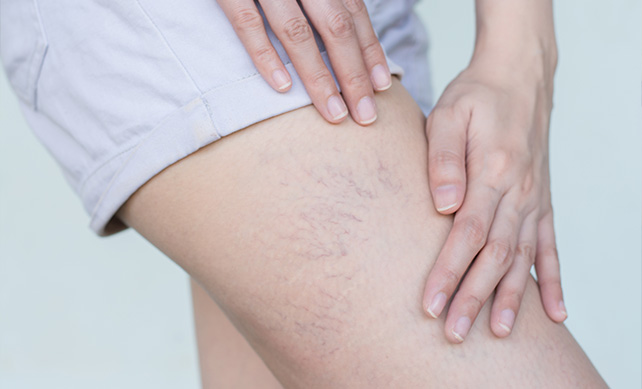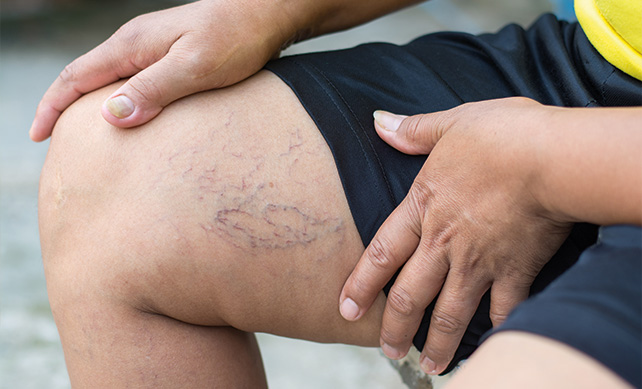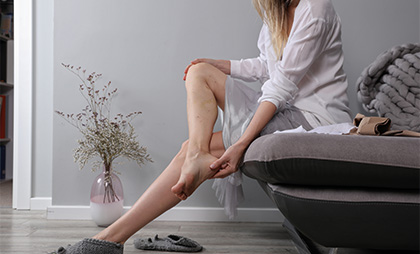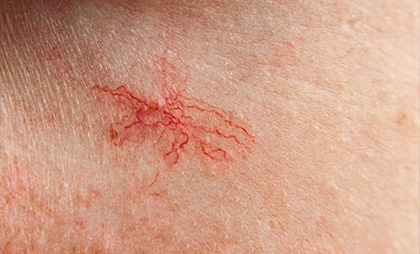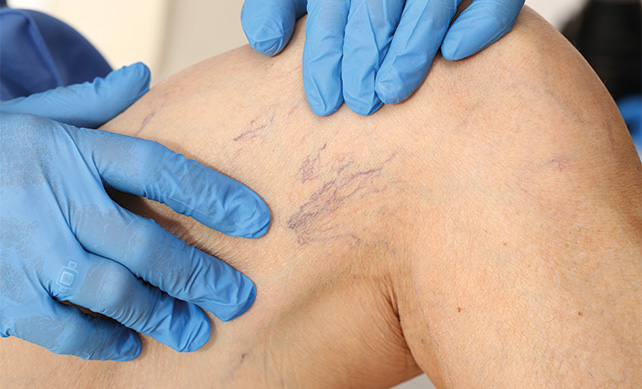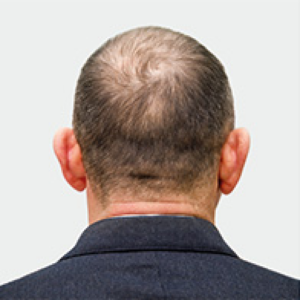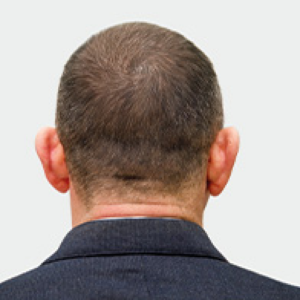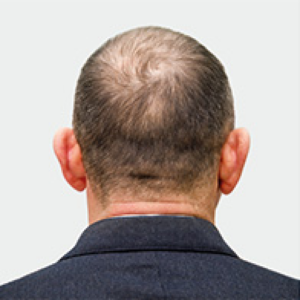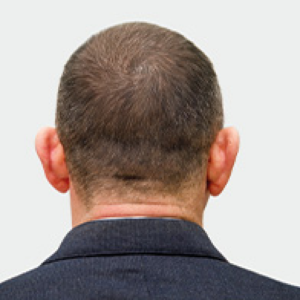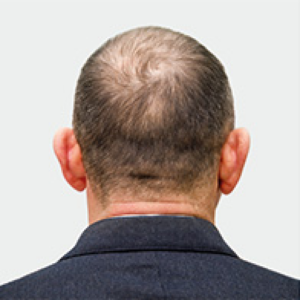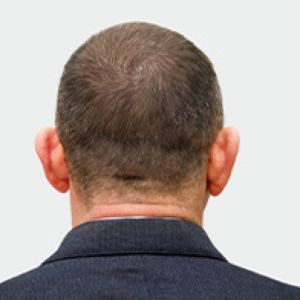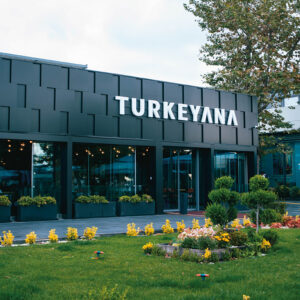Spider Veins
What Are Spider Vein Treatments
Spider veins, also known as telangiectasias, are small, dilated blood vessels near the skin’s surface. They often appear as thin, red, blue, or purple lines or web-like networks of blood vessels. Spider veins are generally harmless and typically occur on the legs and face. While they can be a cosmetic concern for some individuals, they usually do not cause pain or discomfort. The development of spider veins can be attributed to a variety of factors, including:
- Genetics and age.
- Hormonal changes and obesity.
- Prolonged standing or sitting,
- Sun exposure.
Although they are not medically significant in most cases, some people may seek treatment for cosmetic reasons. All treatments aim to;
- Improve the blood flow in your legs and prevent blood clots.
- Enhance calf muscles and prevent veins from swelling.
Treatment options include simple methods and others a bit complicated ones. Like:
- Wear compression stockings or support stockings.
- Physical activity
- Aspirin ibuprofen
- Laser therapy
- Sclerotherapy Injection site
- Surgery in some cases
It is essential to consult a healthcare professional to determine the appropriate treatment for your specific situation.
Everything is to assure you that you are in safe hands…
Spider Veins Treatment
Several treatment options are available for spider veins, depending on their severity and location. The most common treatments include:
- Sclerotherapy: This is the most common treatment for spider veins. It involves injecting a solution called a sclerosant, into the affected veins. The sclerosant causes the walls of the veins to stick together, collapse, and eventually be reabsorbed by the body. Over time, the appearance of the treated veins will fade. Multiple sessions may be needed to achieve the desired results.
- Laser therapy: This non-invasive treatment uses light energy to target varicose veins and spider veins. This damages the spider veins, causing them to collapse and be reabsorbed by the body. Medical devices like Cynosure Elite+ and Cynosure Icon can be used for spider vein treatments. Laser therapy is typically used for smaller spider veins and can also be used in combination with sclerotherapy for optimal results. Several sessions may be required for desired results.
- Endovenous laser treatment (EVLT): This minimally invasive treatment is primarily used for more prominent veins, such as varicose veins. However, it may also be used for more severe spider veins. A small catheter is inserted into the affected vein, and laser energy is delivered through a thin fiber. This causes the vein to collapse and seal shut. The body then reabsorbs the treated vein over time.
- Radiofrequency ablation (RFA): Similar to EVLT, RFA involves the insertion of a catheter into the affected vein. However, radiofrequency energy is used to heat the vein’s walls instead of laser energy, causing it to collapse and seal shut. This treatment is also more commonly used for varicose veins but may be an option for severe spider veins.
- Ambulatory phlebectomy: This is a surgical procedure that involves the removal of spider veins through tiny incisions in the skin. It is typically reserved for more prominent or severe spider veins that are not responsive to other treatment options.
Remember, these treatments have no side effects, and they can help reduce the appearance of spider veins. However, they do not prevent new ones from forming. It is essential to address the underlying factors contributing to spider vein formation, such as;
- Maintaining a healthy weight.
- Exercising regularly.
- And avoiding prolonged periods of standing or sitting.
It is essential to consult with a healthcare professional or vein specialist to determine the most appropriate treatment for your situation.
FAQ
What causes spider veins?
Spider veins are caused by the dilation and swelling of small blood vessels close to the surface of the skin. This can be due to genetics, hormonal changes, obesity, pregnancy, or standing or sitting for long periods of time.
How to get rid of spider veins?
Spider veins can be treated with various medical procedures, such as sclerotherapy, laser therapy, or radiofrequency ablation. It is important to consult with a qualified medical professional to determine the best treatment option for your specific case.
What are spider veins?
Spider veins are small, thin, and twisted blood vessels that can be seen just below the surface of the skin. They are usually blue or red and can appear on the legs, face, or other parts of the body.
Are spider veins dangerous?
Spider veins are generally not dangerous and do not cause any health problems. However, they can be unsightly and may cause discomfort, such as itching or burning sensations.
How to treat spider veins?
Spider veins can be treated with medical procedures such as sclerotherapy, laser therapy, or radiofrequency ablation. These procedures aim to close or remove the affected blood vessels, improving the appearance of the skin.
Do spider veins go away?
Spider veins may not go away on their own but can be effectively treated with medical procedures. In some cases, spider veins may recur after treatment and require additional sessions.
How much does spider vein treatment cost?
The cost of spider vein treatment depends on the type of procedure and the extent of the spider veins being treated. Costs can vary widely and may not be covered by insurance.
How to fix spider veins?
Spider veins can be effectively treated with medical procedures such as sclerotherapy, laser therapy, or radiofrequency ablation. It is important to consult with a qualified medical professional to determine the best treatment option for your specific case. Maintaining a healthy lifestyle and avoiding prolonged standing or sitting can also help prevent the development of spider veins.




BLOG & NEWS
BLOG
Which Breast Augmentation Implant Is the Best?
see all

NEWS
TURKEYANA REDEFINING THE CONCEPT OF BEAUTY
see all


















